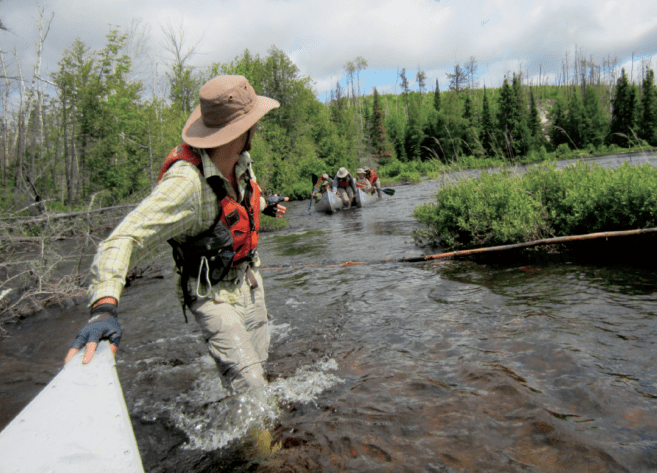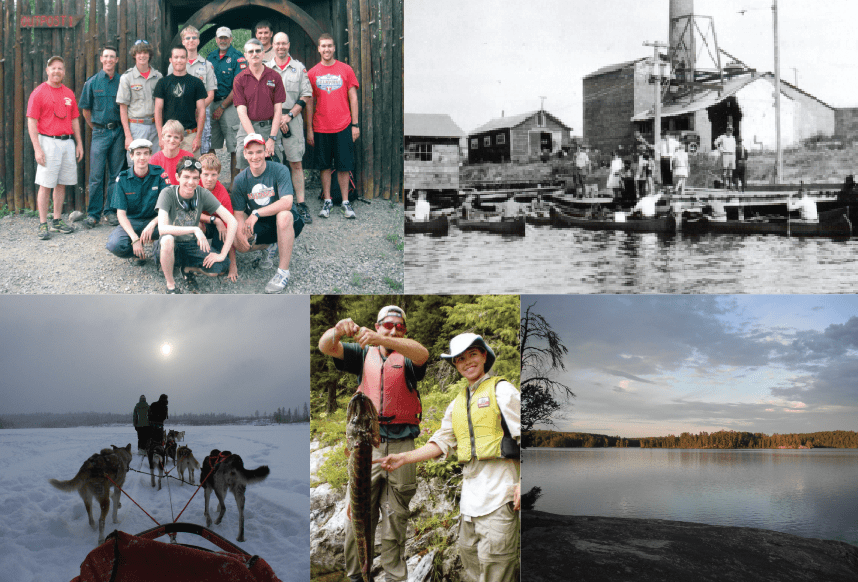Steeped in 90 years of canoeing tradition
By Alissa Johnson

During the summer of 2012, the Northern Tier High Adventure Program helped 755 crews, most of them Boy Scouts, explore the wilderness of northern Minnesota and Canada. That’s 6,012 people starting and ending canoe trips at one of three base camps, and connecting with the boreal forests of the north country through classic wilderness adventure.
“It’s incredible to see a group of six boys come back to the base dirty, covered head to toe in mosquito bites and smiling and talking about all the amazing things they learned,” says Northern Tier’s Director of Program Leslie Thibodeaux. “They’re whole different people.”
At a time when fewer people are canoeing in places like the Boundary Waters Canoe Area Wilderness and Quetico Provincial Park, Northern Tier’s program statistics are refreshing—particularly given the fact that the troops they outfit are choosing to take longer and longer trips.
“At this point, our average crew length has been growing, so people want to spend more time in the wilderness,” Thibodeaux says. Crews typically choose from between six and ten night trips, but for the summer of 2013 a half dozen groups will spend as many as 13 nights on trail. Whatever length, the trips will be a chance to take their Scouting skills to the next level, and the groups will design their adventure around their specific goals and interests.
According to Thibodeaux, Northern Tier is one of four high adventure base camps for the Boy Scouts, and they take pride in being a choose-your-own-adventure kind of program. “If a crew comes in and says I want to paddle 100 miles over the next seven days, or if they come in and say I want to spend 10 days here and love fishing, we’ll help them plan a trip with more fishing or more travel,” she says.
The groups launch from one of three base camps: the Charles L. Sommers Canoe Base outside of Ely, MN, the Donald Rogert Canoe Base in Atikokan, Ontario, or the Northern Expeditions Canoe Base in Bissett, Manitoba. They’ll meet with their interpreter, or counselor, learn about voyageur history, get outfitted with gear and hit the water the next day. With 90 years of program experience, Thibodeaux says Northern Tier has gotten pretty efficient at getting groups on trail.
“There is never a day that we don’t have crews coming into base [to start their trip] or coming off the water,” Thibodeaux says of the Sommers Canoe Base. Located on Moose Lake, the base opened in 1933, but the program got its start as early as 1923 when a single scouting group paddled the Boundary Waters.
“The cost for that seven-day trip was $5.80 per person plus $9 for counsel, or $61.65 for a seven day trip for nine people. It’s a pretty awesome little piece of history right there,” Thibodeaux says.
These days, the typical group going into the Boundary Waters will have six kids, two adults and an interpreter from the base. Most groups plan their trips for two or three years and make their reservations a year and a half before they arrive. “Most really good troops will be set up on a rotation, going to a regular camp near their home this summer and a high adventure camp next summer. They’re planning two to three years in advance and do a lot of fundraising to pay for a trip like this,” Leslie says.

The High Adventure Bases were developed as a way to keep older boys involved in the Scouts. As a result, the majority of the groups coming through Sommers Canoe Base are boy scouts but Northern Tier welcomes girls and boys between the ages of 13 and 20. Girl Scouts troops, groups of adjudicated youth and other public groups get outfitted through Sommers Canoe Base during the summer and winter. Thibodeaux says that’s a little know fact about Sommers: they’re not just about summer Boundary Waters trips.
“We just had a five day dog sled trip pull out of here as I was pulling in this morning,” Thibodeaux says. Winter groups camp on the ice for two to five nights, “dog sledding, snowshoeing, skiing, hiking and sleeping in a quinzy or whatever crazy shelters they choose to build.”
Last year, the base outfitted 72 winter crews for a total of 600 people, and this season they had hit 82 crews and nearly 700 people by February. “We are a full outfitter in the winter. As long as they show up with a hat and long underwear we can provide the rest,” Thibodeaux says.
That kind of full service outfitting—providing the gear, the provisions, and the interpreters—is perhaps what makes it possible for Sommers and Northern Tier to introduce so many groups to the wilderness. They have the process of outfitting down to a science so the troops can get out to where the magic begins: canoe country.
This article appeared in the Spring 2013 issue of Wilderness News

